Page updated: 30 January 2014
 No Definitive Records
No Definitive Records
No Class Association for the SeaHawk was ever formed and all the various manufacturers of the boat are now out of business. There are, therefore, no definitive records available to owners today on which to base an assessment of the age of their boat. If a boat does not come with an original bill of sale, or other documentary evidence, then any assessment of its date can only be approximate.
In these circumstances, it is understandable that many SeaHawk owners appear not know the age of their boat and, perhaps misled by an owner's guess, brokers often quote the wrong builder, giving a new owner the wrong impression. This page is intended to help buyers make an informed assessment of the likely date of any boat they view.
If dating of SeaHawks is to become more accurate then we need to have further information about the earliest and latest boats that have certain features. If you can help close the gap in some of the information below please post the details on the Forum attaching any relevant photographs.
 Known Dates
Known Dates
Unfortunately, there are very few owners who are reasonably sure how old their SeaHawk is. The following are the only dates known with any degree of certainty:
#232 was bought, in April 1973, direct from Reedcraft. Staged payments were made in advance of delivery, in order to avoid the worst effects of the about to be introduced VAT, which replaced Purchase Tax.
#279 was built in 1973 and bought on 15 January 1974 from Gorleston Marine for "£1,222.48 boat, trailer, engine, sails, cover, and no V.A.T.!" The basic price of the boat was then £695.
#390 is believed to have been bought in 1986 on the basis that the third owner inherited from the previous owner a Moore's price list for that year, together with Moore's brochures for the boat.
#412 is known to have been displayed by Moores at the Earls Court boat show in 1992.
#502 was bought on 13 May 2002. The receipt read, "One ex display Sea Hawk Sailing boat including sails and rigging - £6500. One new Indespension braked trailer with lightboard - £1200. One new Mercury 3.3hp Long shaft outboard - £500. Total - £8200. Special price - £8000".
 Conclusions:
Conclusions:
The dates above suggest that just under 70 boats per year were built in the first four years, a remarkably high number. It seems more likely that a significant block of numbers were skipped and this may account why so few boats with low numbers are known.
It appears that production after 1973 fell back dramatically, averaging only 15 boats a year in the next four years up till 1977. This is on the basis that the first boat Moore's boat was about #340. As described on the History Page, the first Moore's boats, those numbered in the 340s, are being termed "Crossover" boats as they have features that were once thought of as being exclusive to either Reedcraft or Moore's boats. The highest sail number currently known for a Moore's boat is #412. This, in turn, suggests their production averaged 12 boats a year, although it started higher and dropped off. There then appears to be another significant gap in sail numbers as Pyefleet starting numbering from #500.
Those who want to try to assess the age of their boat with great precision, will need to take account of the following sections...
 The Hull
The Hull
Unlike some boats, SeaHawks do not generally appear to have had any unique identification marks laid into the resin of the hull. Just one owner has reported "She is no 405 built by Moores. This number is also stamped on the companionway threshold". However, one must wonder if this report has misidentified a mark on the keel handle.
However, it is easy to distinguish the boats built by Reedcraft and Moores and the handful of later boats can also easily be identified. Unfortunately, this only brackets boats as before or after 1977, when manufacturing changed from Reedcraft to Moores and after 1998 when Moores ceased trading. The final boats, built after 1998, were subject to the newly introduced RCD regulations so are also distinctive.
The easiest way to distinguish Reedcraft and Moore's boats is by looking at the cockpit lockers. Below is a typical example of a Reedcraft cockpit locker, essentially a bin with a flange set into a hole cut in the side of the cockpit:
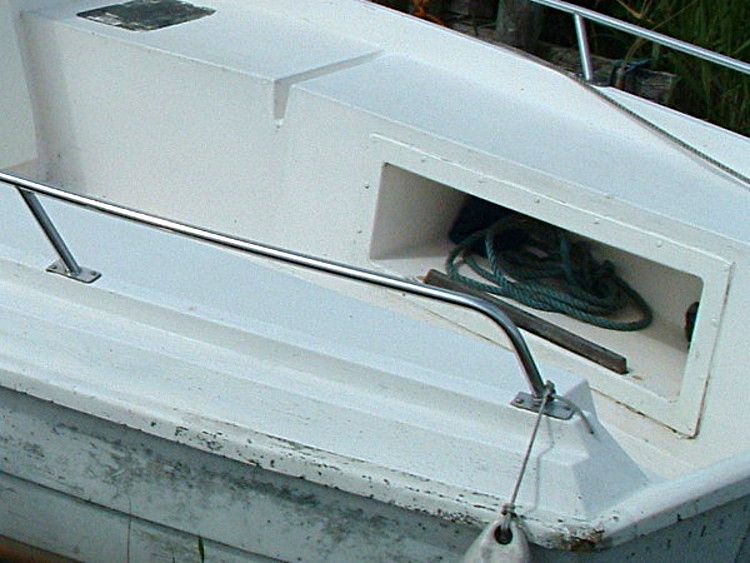
However, it has recently been discovered that the earliest boats built by Moores (with sail numbers in the mid 340s) had a mix of features, including the cockpit lockers of the older Reedcraft boat and the jib sheet winches typically only seen on Moores boats. All but the final few Moores boats had a distinctive style of cockpit locker, fitted during construction, before hull and superstructure are bonded together.
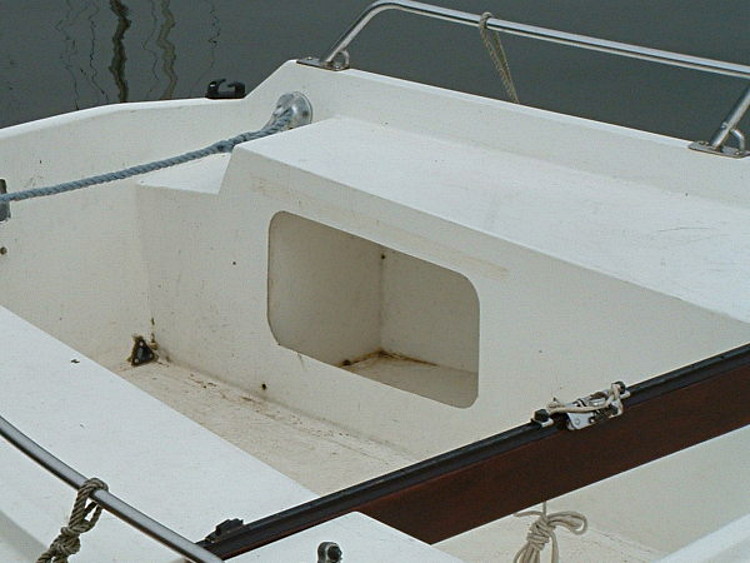
Most SeaHawks will have lockers of one of these two types. There is more detail about variations in Cockpit Lockers in SeaHawks the Description Section of the site.
 Exposed Ballast
Exposed Ballast
Further indicators that help provide finer dating than by manufacturer are certainly not definitive, except for one crucial difference in early Reedcraft boats. These have exposed concrete ballast in the central keel. To confirm the boat being viewed is of this type lift the rectangular wooden plate in the cabin floor to reveal the pivot bolt.
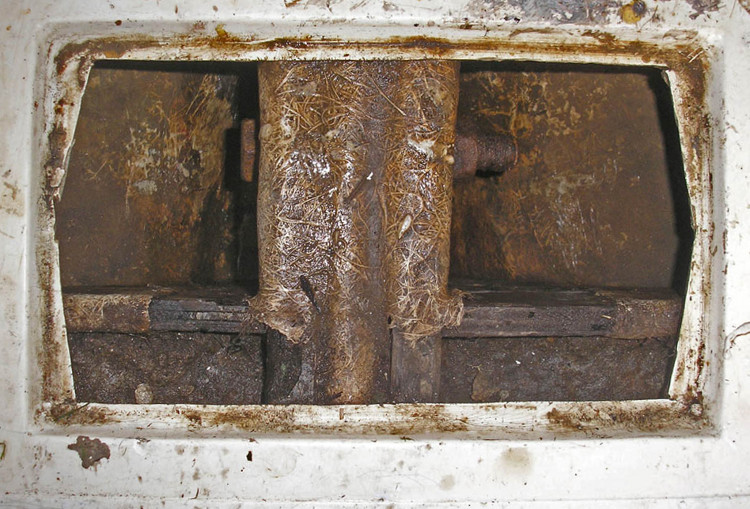
In an early boat you will see concrete held in place by plywood shuttering (as above). Later boats have a heavier denser ballast, fully encased in GRP, whose leading edge is set further aft. It is probable that the change to the denser ballast was made at the same time as the change from black anodised spars took place, which is believed to have been between boat #146 and #154. If you have a boat with numbers near this range please send details of the type of ballast you have with any further information or photographs that might help determine when the change was made.
 Sails
Sails
As all SeaHawks produced by Reedcraft and Moores were supplied with Jeckells sails and these can also be dated by the sailmaker's labels, you may be able to get a closer date than that deduced from the hull alone.
However, as there was no registration system and few owners have been involved in competitive racing, a number of boats appear to have obtained replacement sails from other boats. For example, photographs of the following two boats show all the hallmarks of a Reedcraft boat: Beagle (#376) and Angela (#393) but the sail numbers are within the range issued during the time of Moore's construction. The owner of #393 is deeply suspicious of his sail number, believing it more likely it should have a number below 200. However, without other evidence, he kept the number when ordering his new set of sails.
A sail number, therefore, cannot be taken as a definitive indication of a boat's age. In spite of that caveat, a sail number is often the best general indicator of a boat's age, and if the date suggested is not in conflict with the other indicators then it can be taken as suggesting the likely age.
Photographs of the various Jeckell's sail logos and their dates can be found in the Description Section.
 Spars
Spars
The marketing material produced by Reedcraft indicate that early boats had black anodised mast and boom. The date when anodised spars ceased to be fitted is believed to be between boat #146 and #154. If you have a boat with a number near this range please send details of your spars and the type of ballast you have with any further information or photographs that might help determine when the change was made.
At first the only change seems to have been to drop the black colour. However, at some point between #154 and around #200 it appears that new spars were supplied. In this the boom was near circular in cross-section with the gooseneck designed to permit roller reefing. These spars were certainly used up till the high #200s and probably till the end of Reedcraft production.
Moore's boats seem to have been supplied with Holt Allen spars, with Z-Spars the supplier for the most recent craft built after Moores ceased production.
Further information about Rigging can be found in the Description Section. Photographs of the other types spars to complete the details found on the Rigging page would be welcome.
 Steelwork
Steelwork
Pulpits and cockpit guard rails vary and were always optional extras. However, the "low" type of cockpit guard rail, seen below, has not yet been confirmed to have been fitted to a boat of higher sail number than #232.

Below is the more common "standard" guard rail found on the vast majority of SeaHawks. However there are variants. More details of Steelwork can be found in the description Section.

 Other Marks
Other Marks
It appears that early Reedcraft boats were fitted with a variety of devices that may, by their presence, help date a boat.
On the right below is a builders label found on the starboard shroud anchorage point of Pippin (#120). Pippin also had a circular blue plate showing a certificate number from the Ship and Boat Builders National Federation, although the example below comes from another boat, probably of the same vintage. The owner who supplied the photo reports that it wasn't fitted when he bought his boat, saying, "I asked the previous owner where this was originally fitted and as far as he can remember it was on a bunk level bulkhead just forward of the keel."
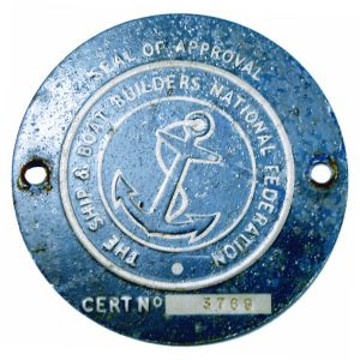
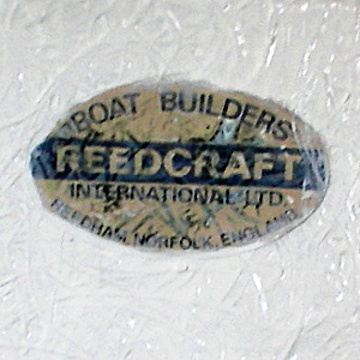
Although the documentation that came with the SBBNF plate suggests a general type approval, it would seem that the SBBNF certificate number is applied to an individual boat and so might provide a precise date for a vessel. However, since 1986 when the SBBNF became the British Marine Industries Federation, all the SBBNF records were transferred to the archives at Warwick University, and so are not easily accessible.
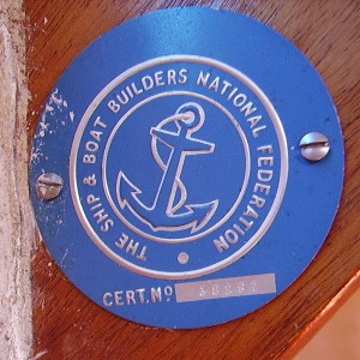
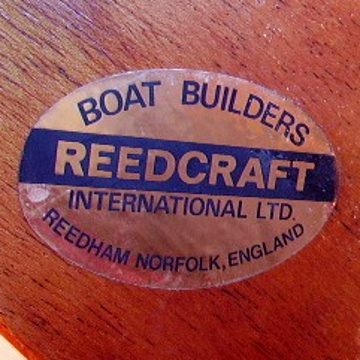
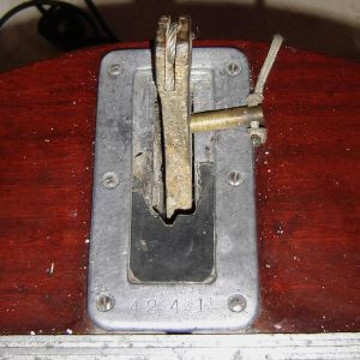 The
SBBNF plaque could easily be unscrewed and lost during a cabin
refit. The Reedcraft label is simply a metalised self adhesive label
and if loosened would be even more fragile.
The
SBBNF plaque could easily be unscrewed and lost during a cabin
refit. The Reedcraft label is simply a metalised self adhesive label
and if loosened would be even more fragile.
It is known that neither of these items were fitted to SeaHawk #232, which might suggest that they ceased to be fitted at some point before that.
One other place where some owners report an identification number is on the keel handle fitting. However, more than one has reported the number "4086" stamped on this casting, so it appears not to indicate a unique hull number and its function remains a mystery.
Any further detail that would help refine the information on this page would be welcome. Please use the Forum posting photographs or other evidence if relevant.
